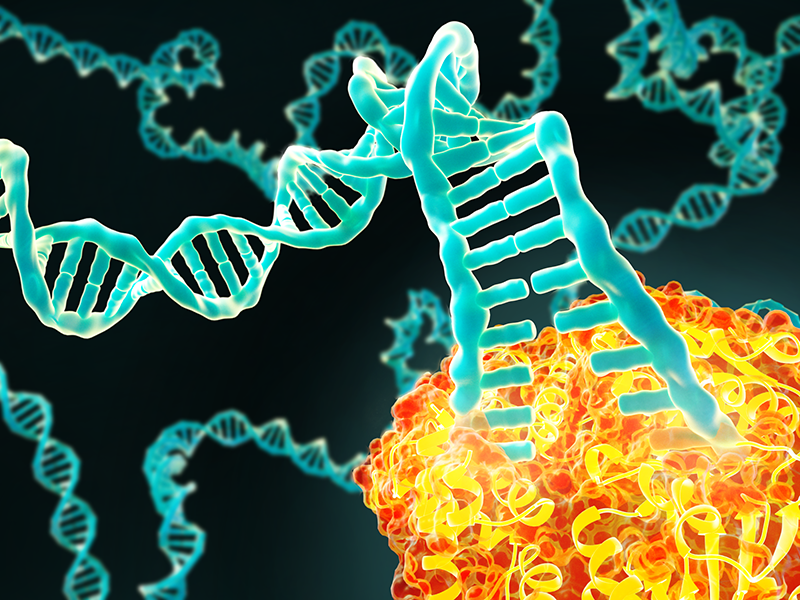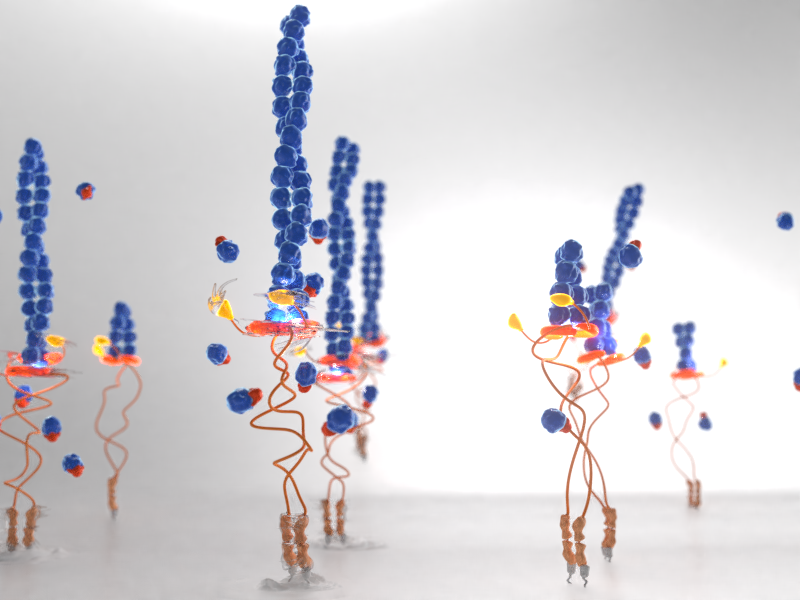Predicting DNA-protein interactions
Fast quantification of DNA-protein interactions under force and torque constraints
Written by Steven Wolf, PhD with Artem Efremov, PhD, Yan Jie Lab | Illustration by Melanie Lee, PhD | June 2018
Researchers from the Mechanobiology Institute, and Department of Physics, National University of Singapore, have developed a powerful theoretical framework for fast calculations of the conformation, or shape, of DNA, in the presence of DNA-binding proteins, with mechanical constraints imposed on the DNA. The resulting computational methods demonstrated very high efficiency, outperforming all existing numeric algorithms by several orders of magnitude. This work, conducted by Artem Efremov and Yan Jie, has been published in Nucleic Acids Research journal.

An artistic depiction of DNA-protein interactions.
DNA-architectural proteins
It is well known that DNA, which carries the genetic information in nearly all living cells, is several thousand times longer than the cell itself. Despite this, the molecule must fit inside the tiny volume of the nucleus, and to ensure this is achieved without damaging the genetic information, cells employ specialized proteins, known as ‘architectural proteins’. Their primary function is the compaction of the DNA molecule into a condensed structure known as chromatin.
The process of DNA compaction occurs in a highly ordered manner, so as to allow other important DNA-binding proteins, such as those that decode or repair the molecule, to perform their duties. In this sense, DNA-architectural proteins also ensure gene transcription, which is the process by which the DNA is read by the cell, remains regulated throughout the compaction process.
Role of mechanical forces in regulation of DNA-protein interactions
Recently acquired evidence suggests that interactions between DNA and architectural proteins may be driven by numerous mechanical and topological constraints imposed on DNA. For example, several DNA motor proteins, such as polymerases, helicases and topoisomerases, which track along DNA as they read, unwind or untangle the molecule, can exert strong mechanical forces to the compacted chromatin. This in turn has a profound effect on the stability of any interactions between DNA and the architectural proteins.
In addition, large forces generated during cell movement, contraction, or as the cell senses its environment, may be transmitted to DNA through the cytoskeletal networks. These networks are directly connected to the nucleus, and chromatin. Thus, the shape of chromosomal DNA in living cells is determined by the intricate interplay between different DNA-architectural proteins, which are themselves subject to various mechanical and topological constraints.
Predicting the effect of mechanical constraints on DNA-protein interactions
With the DNA under constant strain from its condensation, and with the activity of different proteins producing ever changing physical conditions within the chromatin structure, it is imperative that the physical conditions of DNA be considered when predicting DNA-protein interactions.
By using algorithms with a very fast calculation rate, we have developed a semi-analytical theoretical framework that can predict DNA-protein interactions under mechanical and topological constraints.
To date, most attempts to predict DNA-protein interactions rely on bulk measurements of DNA-protein binding affinities. That is, the average degree to which proteins will bind to DNA. Only recently has technology enabled researchers to consider the behavior of single proteins, in specific situations or under unique physical conditions. Although these biophysical methods now provide researchers with detailed measurements of individual DNA-protein interactions under precisely controlled mechanical and topological constraints of DNA, a general theoretical framework that allows the resultant experimental data to be interpreted remains lacking.
Most theoretical studies used to analyze such single-molecule studies rely on calculations of repeated random sampling, or simulations of random molecular dynamics, such as Metropolis-Monte Carlo calculations or Brownian dynamics simulations. These methods however, require extensive computational resources and are too slow to allow variation in the simulation parameters, which define the physical characteristics of DNA and possible protein-DNA complexes.
Now, to provide better insights into DNA-protein interactions under mechanical and topological constraints, Efremov A. K. and Yan J. have developed a semi-analytical theoretical framework that overcomes these problems by using algorithms with a very fast calculation rate. Parameters may be varied in the course of the analysis, and this has allowed the researchers to obtain important information about the physical and geometric characteristics of DNA-protein complexes from single-molecule experimental data. It is hoped that the methods proposed by Efremov and Yan, will enable greater insights into the molecular mechanisms that govern DNA-protein interactions, and provide detailed insights to predict how various forces, including rotational force or torque, affect the binding affinity of different types of DNA-interacting proteins, when force is applied to DNA.










